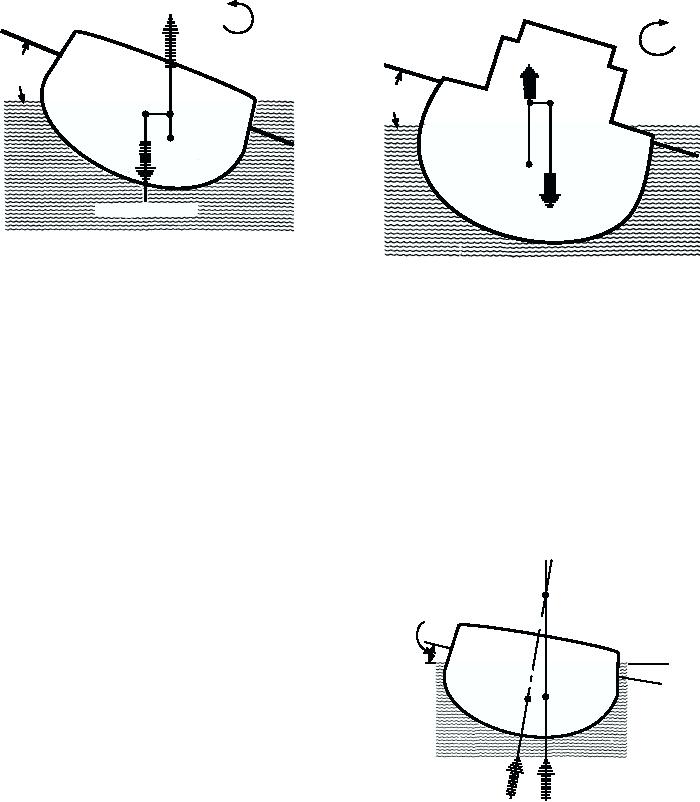
However, it is possible for conditions to exist which
If you study figure 12-20, you will notice that a
do not permit B to move far enough in the direction in
RIGHTING or RESTORING MOMENT is present.
which the ship rolls to place the buoyant force outboard
This righting moment is caused by the two equal and
of the force of gravity. The moment produced will tend
opposite forces, each of W tons (displacement)
to upset the ship, rendering it unstable. Figure 12-21
magnitude, separated by a distance GZ, which
shows an unstable ship in which the relative positions of
constitutes the LEVER ARM OF MOMENT. Figure
B and G produce an UPSETTING MOMENT. In this
12-20 shows that the ship is stable because the center of
illustration it is obvious that the cause of the upsetting
buoyancy (B) has shifted far enough to position the
moment is the high position of G (center of gravity) and
buoyant force where it tends to restore the ship to an
the GEOMETRIC CENTER OF THE UNDERWATER
even keel or an upright position.
BODY (B--the center of buoyancy).
DIRECTION OF
RIGHTING MOMENT
FORCE OF BUOYANCY
ANGLE
DIRECTION OF
OF
UPSETTING
HEEL
MOMENT
ANGLE
OF
G
Z
HEEL
Z
G
B
B
FORCE OF GRAVITY
FORCE OF GRAVITY
DCf1220
Figure 12-20. Development of righting moment when a stable
DCf1221
ship inclines.
Figure 12-21. Development of an upsetting moment when an
unstable ship inclines.
A moment is the product of a force tending to
Metacenter
produce a rotation about an axis times its distance from
the axis. If two equal and opposite forces are separated
A ship's METACENTER (M) is the intersection of
by a distance, the moment will become a couple which
two successive lines of action of the force of buoyancy,
is measured by ONE of the forces times the distance
as the ship heels through a very small angle.
that separates them. The RIGHTING MOMENT of a
Figure 12-22 shows two lines of buoyant force. One of
these represents the ship on even keel, the other at a
ship is therefore the product of the force of buoyancy
small angle of heel. The point where they intersect is
times the distance GZ (fig. 12-20) that separates the
the initial position of the metacenter. When the angle of
forces of buoyancy and gravity. It may also be
heel is greater than the angle used to compute the
expressed as the force of gravity (weight of the ship)
metacenter, M moves off the centerline and the path of
times GZ. The distance GZ is known as a ship's
movement is a curve.
RIGHTING ARM. Putting this into mathematical
terms, you have the following:
M
Righting moment = W x GZ (expressed in
ANGLE OF HEEL
IS EXAGGERATED
foot-tons)
C
L
Where:
WATERLINE
UPRIGHT
W = displacement in tons
WATERLINE
B2
B1
INCLINED
TO A VERY
GZ = righting arm in feet
SMALL
ANGLE
For example, if a ship displaces 10,000 tons and
has a 2-foot righting arm at 40 inclination, the righting
BUOYANT FORCE
BUOYANT FORCE
INCLINED
UPRIGHT
moment is 10,000 tons times 2 feet, or 20,000
foot-tons. These 20,000 foot-tons represent the force,
DCf1222
which tends to return the ship to an upright position.
Figure 12-22. The metacenter.
12-9

